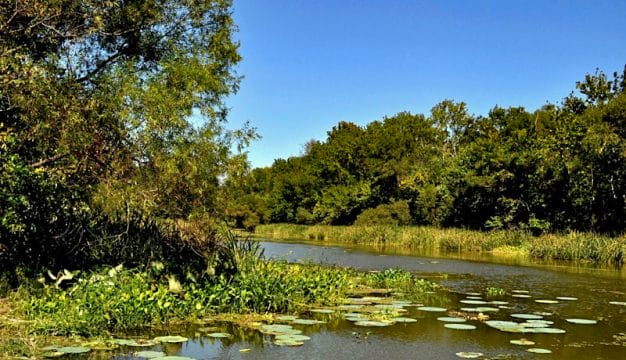Pike County
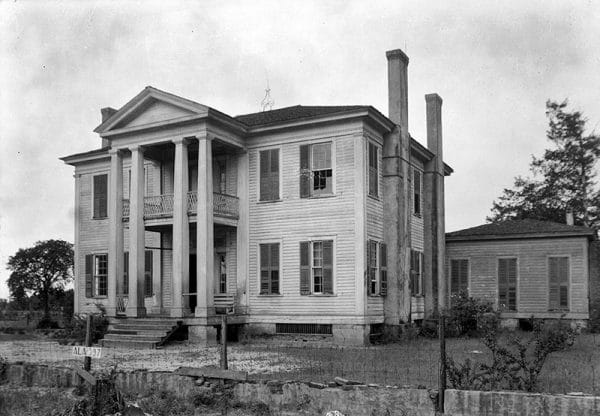 Solomon Siler House
Located in the southeast part of the state, Pike County is home to Troy University, which has campuses in many parts of the state and in several locations in Asia and Europe. The county is also the home of Antique City in Brundidge, a series of antique shops housed in buildings dating back to the early nineteenth century. Pike County is governed by an elected six-member commission and includes four incorporated communities.
Solomon Siler House
Located in the southeast part of the state, Pike County is home to Troy University, which has campuses in many parts of the state and in several locations in Asia and Europe. The county is also the home of Antique City in Brundidge, a series of antique shops housed in buildings dating back to the early nineteenth century. Pike County is governed by an elected six-member commission and includes four incorporated communities.
- Founding Date: December 17, 1821
- Area: 672 square miles
- Population: 33,009 (2020 Census estimate)
- Major Waterways: Conecuh River, Pea River
- Major Highways: U.S. 231, U.S. 29
- County Seat: Troy
- Largest City: Troy
History
 Pike County Courthouse
Pike County was created from portions of Henry and Montgomery Counties by an act of the Alabama General Assembly on December 17, 1821. The county’s boundaries changed several times with the creation of Barbour, Bullock, and Crenshaw Counties. The present-day boundaries were set in 1897. Pike County was named for Gen. Zebulon Montgomery Pike, an explorer and statesman from New Jersey who mapped much of the southern portion of the Louisiana Purchase; Pike’s Peak in Colorado is also named for him. Most early settlers came from the Carolinas and were of Scots-Irish origin. Others came from Georgia via the Old Federal Road. Some of the earliest settlements and towns were Orion, Brundidge, Henderson, China Grove, and Goshen.
Pike County Courthouse
Pike County was created from portions of Henry and Montgomery Counties by an act of the Alabama General Assembly on December 17, 1821. The county’s boundaries changed several times with the creation of Barbour, Bullock, and Crenshaw Counties. The present-day boundaries were set in 1897. Pike County was named for Gen. Zebulon Montgomery Pike, an explorer and statesman from New Jersey who mapped much of the southern portion of the Louisiana Purchase; Pike’s Peak in Colorado is also named for him. Most early settlers came from the Carolinas and were of Scots-Irish origin. Others came from Georgia via the Old Federal Road. Some of the earliest settlements and towns were Orion, Brundidge, Henderson, China Grove, and Goshen.
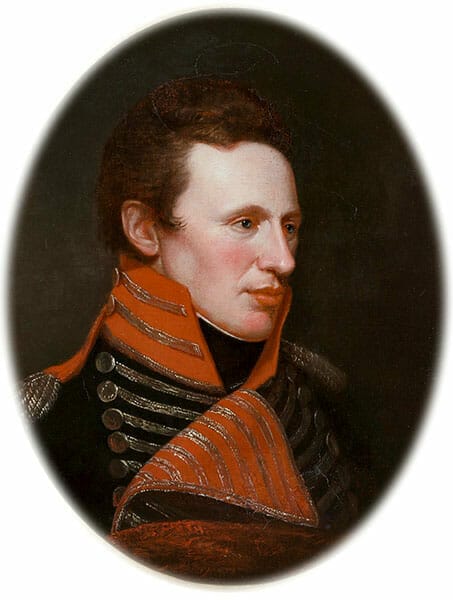 Zebulon Montgomery Pike
The 1821 act creating the county provided for a temporary seat of justice at the house of Andrew Townsend in Louisville until Pike County commissioners selected the site for the county seat. Little is known about this first seat, as Louisville eventually became a part of Barbour County. The Pike County seat was moved to Monticello in 1827, and a log courthouse was built in 1828. That building was torn down in 1839 and rebuilt as an inn, which was itself eventually torn down. In 1837, the citizens wanted a more centrally located seat of justice, so the county seat was moved to Troy, which was originally known as Deer Stand Hill. The court met in local stores until the courthouse was built in 1839. In 1880, this structure was torn down and rebuilt as an opera house, which was also eventually torn down. A brick courthouse was erected in 1880 and expanded in 1898. Over the course of the twentieth century, the courthouse was restored and remodeled and remains in use.
Zebulon Montgomery Pike
The 1821 act creating the county provided for a temporary seat of justice at the house of Andrew Townsend in Louisville until Pike County commissioners selected the site for the county seat. Little is known about this first seat, as Louisville eventually became a part of Barbour County. The Pike County seat was moved to Monticello in 1827, and a log courthouse was built in 1828. That building was torn down in 1839 and rebuilt as an inn, which was itself eventually torn down. In 1837, the citizens wanted a more centrally located seat of justice, so the county seat was moved to Troy, which was originally known as Deer Stand Hill. The court met in local stores until the courthouse was built in 1839. In 1880, this structure was torn down and rebuilt as an opera house, which was also eventually torn down. A brick courthouse was erected in 1880 and expanded in 1898. Over the course of the twentieth century, the courthouse was restored and remodeled and remains in use.
Major Cities and Demographics
According to the 2020 U.S. Census, the population of Pike County was 33,009. Of that total, 57.2 percent of respondents identified themselves as white, 38.4 percent as African American, 2.4 percent as Hispanic, 1.9 percent as two or more races, 1.7 percent as Asian, 0.7 percent as Native American, and 0.1 percent Hawaiian or Pacific Highlander. The county seat Troy is the largest city in the county with an estimated population of 18,995. Other significant population centers include Brundidge, Goshen, and Banks. The median household income was $39,218, compared with $52,035 for the state as a whole, and the per capita income for Pike County was $23,784, compared with $28,934 for the state as a whole.
Economy
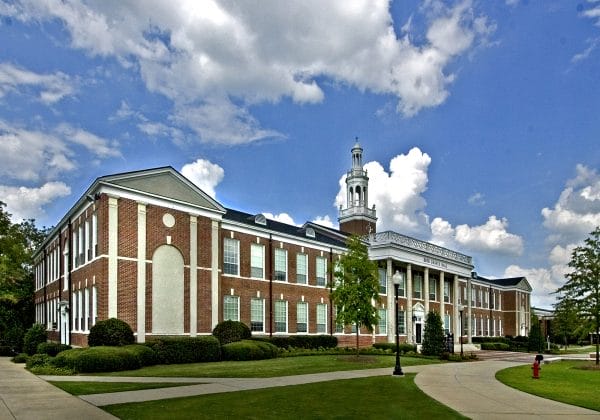 Troy University
Pike County’s thin, sandy soils were fertile when farmers first arrived in the early eighteenth century, but after just a year or two of farming, the soil became depleted. Thus, before the Civil War, Pike County did not develop the large farms and plantations so common in other areas of Alabama, and agriculture remained mainly at the subsistence level. After the Civil War, however, farmers learned to terrace the land to retain the topsoil and began adding commercial fertilizers. Cotton soon became a major cash crop until the boll weevil arrived in the mid-1910s, followed by the Great Depression in the 1930s. Farmers diversified into other agricultural activities, especially peanuts and livestock, and other industries began to develop, including gristmills and lumber mills. In the 1960s and 1970s, steel and plastic production became important when Lockheed Martin and KW Plastics Recycling opened.
Troy University
Pike County’s thin, sandy soils were fertile when farmers first arrived in the early eighteenth century, but after just a year or two of farming, the soil became depleted. Thus, before the Civil War, Pike County did not develop the large farms and plantations so common in other areas of Alabama, and agriculture remained mainly at the subsistence level. After the Civil War, however, farmers learned to terrace the land to retain the topsoil and began adding commercial fertilizers. Cotton soon became a major cash crop until the boll weevil arrived in the mid-1910s, followed by the Great Depression in the 1930s. Farmers diversified into other agricultural activities, especially peanuts and livestock, and other industries began to develop, including gristmills and lumber mills. In the 1960s and 1970s, steel and plastic production became important when Lockheed Martin and KW Plastics Recycling opened.
Employment
According to 2020 Census estimates, the workforce in Pike County was divided among the following industrial categories:
- Educational services, and health care and social assistance (24.2 percent)
- Retail trade (14.5 percent)
- Manufacturing (11.9 percent)
- Arts, entertainment, recreation, and accommodation and food services (9.4 percent)
- Professional, scientific, management, and administrative and waste management services (8.4 percent)
- Transportation and warehousing, and utilities (7.8 percent)
- Construction (5.6 percent)
- Public administration (5.6 percent)
- Finance and insurance, and real estate, rental, and leasing (4.1 percent)
- Other services, except public administration (3.1 percent)
- Wholesale trade (2.1 percent)
- Agriculture, forestry, fishing and hunting, and extractive (2.0 percent)
- Information (1.3 percent)
Education
Pike County Schools oversees six primary and secondary schools, and Troy City Schools oversees four primary and secondary schools. Troy University, the second largest university in the state (including worldwide enrollment), is a traditional four-year institution offering degrees at both the undergraduate and graduate levels. The home campus is located in Troy, and the university also maintains more than 60 satellite campuses in 17 states and 11 countries, many located on and near military installations for the benefit of military personnel.
Geography
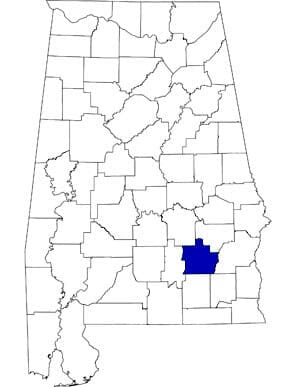 Pike County Map
Comprised of approximately 670 square miles, Pike County is part of the Coastal Plain physiographic section. Pike County is bordered by Bullock County to the northeast, Barbour County to the east, Dale County to the southeast, Coffee County to the south, Crenshaw County to the west, and Montgomery County to the north.
Pike County Map
Comprised of approximately 670 square miles, Pike County is part of the Coastal Plain physiographic section. Pike County is bordered by Bullock County to the northeast, Barbour County to the east, Dale County to the southeast, Coffee County to the south, Crenshaw County to the west, and Montgomery County to the north.
The Conecuh River runs diagonally through the county from the northeast to the southwest and is home to 95 species of fish and 30 species of mussel, many of which are at risk. The Pea River forms part of Pike County’s eastern border and is the largest tributary of the Choctawhatchee River. Big Creek and Whitewater Creek, significant tributaries of the Pea River, originate just below Troy. U.S. Highway 231 and U.S. Highway 29 are Pike County’s major transportation routes. U.S. Highway 231 runs north-south, and U.S. Highway 29 runs east-west. Troy Municipal Airport in Troy is the only public airport in the county.
Events and Places of Interest
Pike County offers many opportunities for recreational activities. The Pike County Pocosin Tract nature preserve just east of Troy covers 190 acres and supports unique plant communities. Visitors may attend educational workshops as well as hike, hunt, and fish. Located five miles south of Troy, the Pike County Lake covers 45 acres and affords visitors opportunities to fish and boat as well as picnic along the shoreline. L&L Lakes, also south of Troy, consists of three lakes totaling more than 125 acres that are open for fishing and picnicking.
 Pioneer Museum
The Pioneer Museum of Alabama in Troy opened in 1971 and is located on 25 acres of woodlands that includes a nature trail. The museum houses more than 16,000 artifacts in 17 historical buildings, including a gristmill, smokehouse, one-room schoolhouse, general store, and train depot. The National Band Association established the National Band Association Hall of Fame on the campus of Troy University in 1979. Officially opened in 1980, the hall celebrates those persons who have distinguished themselves as conductors in the field of band. The Johnston Peanut Butter Mill, where more than two million jars of peanut butter were produced annually during the Great Depression, is now a museum housing artifacts from that era, including photographs, equipment, and memorabilia from the annual Peanut Butter Festival held each October. In addition, visitors to the Troy Historic District can see 13 antebellum homes as well as a restored downtown square. Also located in the downtown area is the Johnson Center for the Arts, housed in a historic post office with additional exhibit space in a restored warehouse.
Pioneer Museum
The Pioneer Museum of Alabama in Troy opened in 1971 and is located on 25 acres of woodlands that includes a nature trail. The museum houses more than 16,000 artifacts in 17 historical buildings, including a gristmill, smokehouse, one-room schoolhouse, general store, and train depot. The National Band Association established the National Band Association Hall of Fame on the campus of Troy University in 1979. Officially opened in 1980, the hall celebrates those persons who have distinguished themselves as conductors in the field of band. The Johnston Peanut Butter Mill, where more than two million jars of peanut butter were produced annually during the Great Depression, is now a museum housing artifacts from that era, including photographs, equipment, and memorabilia from the annual Peanut Butter Festival held each October. In addition, visitors to the Troy Historic District can see 13 antebellum homes as well as a restored downtown square. Also located in the downtown area is the Johnson Center for the Arts, housed in a historic post office with additional exhibit space in a restored warehouse.
In recent years, TroyFest has become a popular event for the county. Held on the square in downtown Troy, the festival celebrates the cultural arts and introduces local artists to the community and offers antiques, art, food, and entertainment. Another popular event is the annual “Taste of Pike County,” a food and business exposition that takes place in March.
Further Reading
- The Heritage of Pike County, Alabama. Clanton, Ala.: Heritage Publishing Consultants, 2001.
- Stewart, Margaret Estelle. Alabama’s Pike County. Centre, Ala.: Stewart University Press, 1976.

